Do you have a question about the Trane 4TTL5024N1000A and is the answer not in the manual?
Specifies maximum lengths and vertical changes for refrigerant lines.
Guidance on optimal placement for unit performance and airflow.
Precautions for units installed in areas with snow and freezing temperatures.
Recommendations for units installed near salt water environments.
Guidelines for installing the unit on a support pad, ensuring proper drainage and leveling.
Details the required sizes for vapor and liquid refrigerant lines and their connections.
Information on the initial refrigerant charge provided by the factory.
Determining the necessary line length and lift for system charging calculations.
Importance of insulating the vapor line to maintain system efficiency.
Precautions to take when reusing existing refrigerant lines in retrofit applications.
Guidelines for routing refrigerant lines to prevent noise and ensure proper installation.
Methods for isolating line sets from structural elements like joists and rafters.
Techniques for isolating refrigerant lines within wall cavities.
Proper methods for sealing and isolating refrigerant lines passing through walls.
Procedure for properly opening the gas service valve.
Procedure for safely opening the liquid service valve, with warnings.
Defines maximum lengths for low voltage wiring based on wire gauge.
Wiring diagrams illustrating thermostat, air handler, and outdoor unit connections.
Information on high voltage power requirements and safety precautions.
Guidance on installing and using a high voltage disconnect switch.
Procedures for measuring temperatures to ensure correct system charging.
Worksheet for calculating subcooling adjustments based on line length and lift.
Waiting period required for system conditions to stabilize before adjustments.
Measuring and recording liquid line temperature and pressure.
Referencing system pressure curves to confirm operational performance.
Adjusting refrigerant level based on gauge pressure and chart values.
Recording system pressures and temperatures after charging is complete.
Wiring diagram for specific ton models, including legend and notes.
Wiring diagram illustrating connections for various components and models.
Wiring diagram for 3.5 and 4.0 ton models, detailing electrical connections.
Electrical schematic for 3.5 and 4.0 ton models, showing component interconnections.
Pressure curves for 2.0 and 2.5 ton models, illustrating performance at different temperatures.
Pressure curves for 3.0 ton models, showing cooling performance relationships.
Pressure curves for 3.5 and 4.0 ton models, detailing cooling performance data.
Specifies maximum lengths and vertical changes for refrigerant lines.
Guidance on optimal placement for unit performance and airflow.
Precautions for units installed in areas with snow and freezing temperatures.
Recommendations for units installed near salt water environments.
Guidelines for installing the unit on a support pad, ensuring proper drainage and leveling.
Details the required sizes for vapor and liquid refrigerant lines and their connections.
Information on the initial refrigerant charge provided by the factory.
Determining the necessary line length and lift for system charging calculations.
Importance of insulating the vapor line to maintain system efficiency.
Precautions to take when reusing existing refrigerant lines in retrofit applications.
Guidelines for routing refrigerant lines to prevent noise and ensure proper installation.
Methods for isolating line sets from structural elements like joists and rafters.
Techniques for isolating refrigerant lines within wall cavities.
Proper methods for sealing and isolating refrigerant lines passing through walls.
Procedure for properly opening the gas service valve.
Procedure for safely opening the liquid service valve, with warnings.
Defines maximum lengths for low voltage wiring based on wire gauge.
Wiring diagrams illustrating thermostat, air handler, and outdoor unit connections.
Information on high voltage power requirements and safety precautions.
Guidance on installing and using a high voltage disconnect switch.
Procedures for measuring temperatures to ensure correct system charging.
Worksheet for calculating subcooling adjustments based on line length and lift.
Waiting period required for system conditions to stabilize before adjustments.
Measuring and recording liquid line temperature and pressure.
Referencing system pressure curves to confirm operational performance.
Adjusting refrigerant level based on gauge pressure and chart values.
Recording system pressures and temperatures after charging is complete.
Wiring diagram for specific ton models, including legend and notes.
Wiring diagram illustrating connections for various components and models.
Wiring diagram for 3.5 and 4.0 ton models, detailing electrical connections.
Electrical schematic for 3.5 and 4.0 ton models, showing component interconnections.
Pressure curves for 2.0 and 2.5 ton models, illustrating performance at different temperatures.
Pressure curves for 3.0 ton models, showing cooling performance relationships.
Pressure curves for 3.5 and 4.0 ton models, detailing cooling performance data.
| Brand | Trane |
|---|---|
| Model | 4TTL5024N1000A |
| Category | Air Conditioner |
| Language | English |

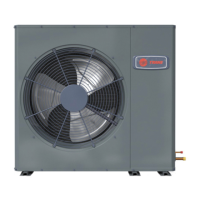

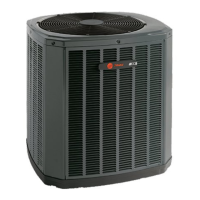
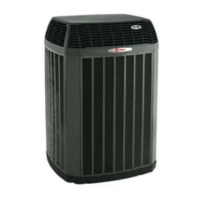
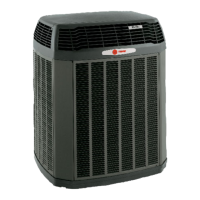

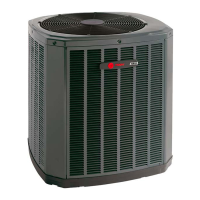




